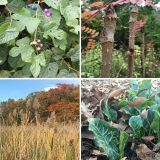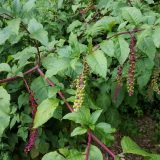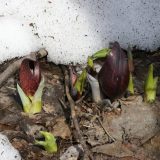Look for Lichens - December 2017
Lichens are formed by a partnership between a photosynthetic alga, which produces food, and a fungus, which provides shelter. Highly sensitive to air quality, lichens were all but eliminated from New York City before federal regulations to curb pollution were enacted in 1970.
Today lichens have recolonized the City with nearly 100 species spread throughout the five boroughs, acting as bioindicators of improved air quality. As New York City gets cleaner, more lichens are returning. Help document the growing biodiversity of the City by observing lichens in your neighborhood.
Take photos of lichens that include at least two corners of a MetroCard (as pictured) or a coin in view for scale. Post your observations on the NYC EcoFlora Project at iNaturalist.
Additional information:
Register to take the course The Hidden World of Lichens, taught by Dr. James Lendemer, NYBG’s curator of lichens.
Buy the field guide Common Lichens of Norteastern North America, from the NYBG Press.
Download the guide What are Lichens?
December 2017 EcoQuest Results:
Total observations for New York City: 202.
Observations by borough: Manhattan, 95; Bronx, 92; Queens, 11; Brooklyn, 3; Staten Island, 1.
Top five observers: laura622, 47; elizajsyh, 37; danielatha, 28; dskacc, 16; mpitaro, 11.
Total number of plants, animals and fungi: 22
Fungi: 135
Lecanoromycetes: 22
Candelaria concolor: 7
Parmeliaceae: 6
Lecanorales: 5
Physcia millegrana: 5
Flavoparmelia: 3
Flavoparmelia caperata: 3
Punctelia rudecta: 2
Physcia: 2
Amandinea: 1
Apiosporina morbosa: 1
Quercus rubra: 1
Cladonia cristatella: 1
Liriodendron tulipifera: 1
Acarospora fuscata: 1
Punctelia: 1
Xanthoparmelia: 1
Parmelia sulcata: 1
Pertusaria pustulata: 1
Phaeophyscia rubropulchra: 1
Lecanora: 1
Thank you for your participation!

 The New York City EcoFlora project is made possible in part by the Institute of Museum and Library Services [MG-70-19-0057-19].
The New York City EcoFlora project is made possible in part by the Institute of Museum and Library Services [MG-70-19-0057-19].




